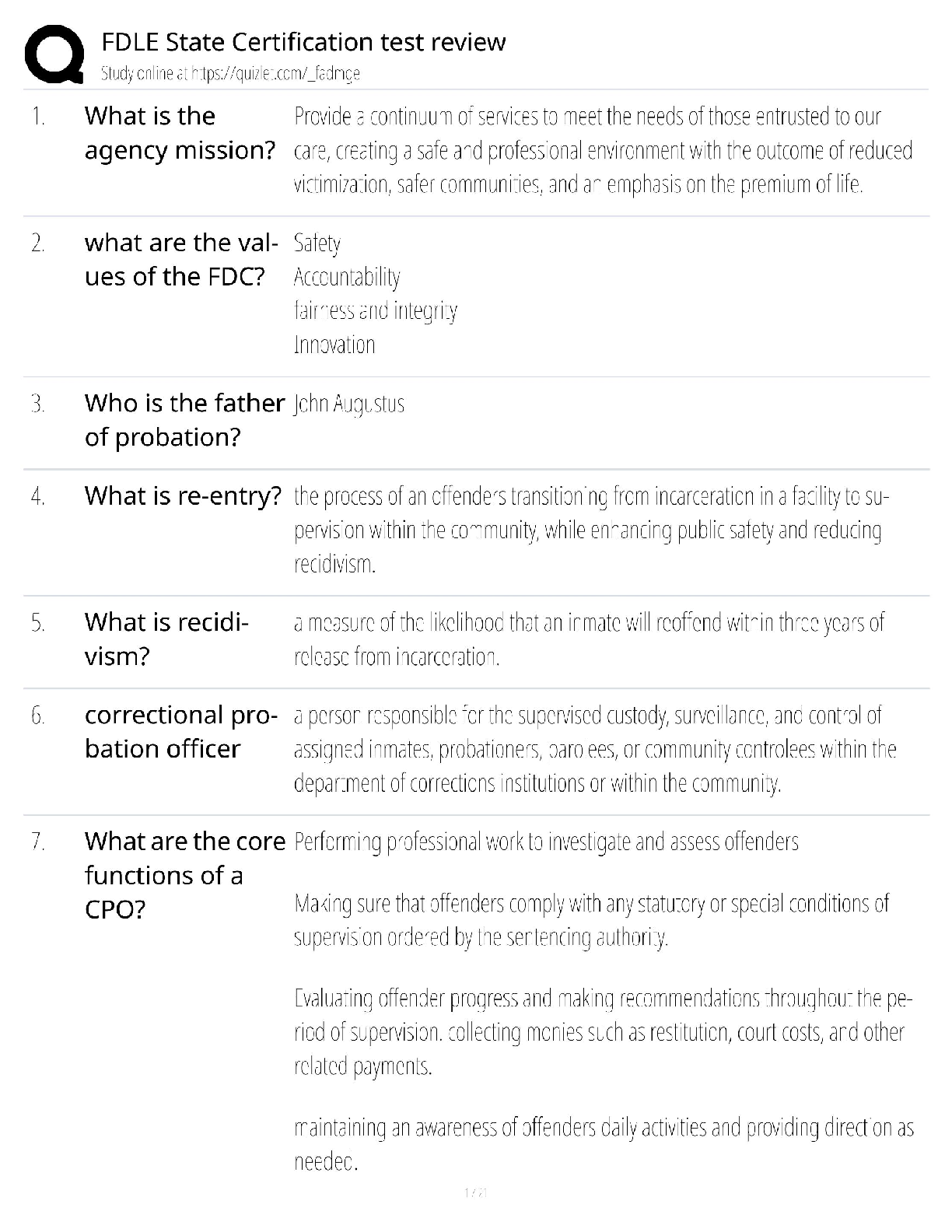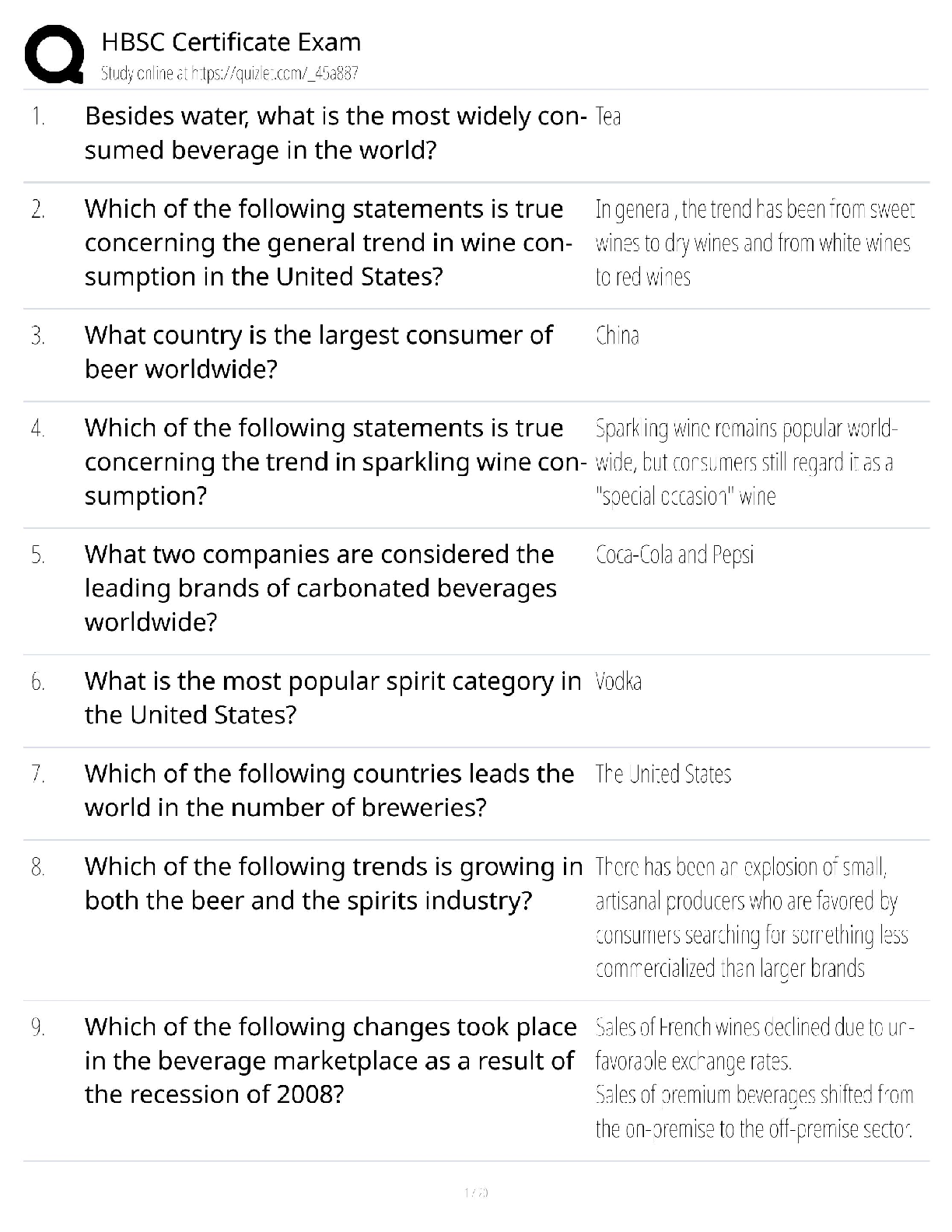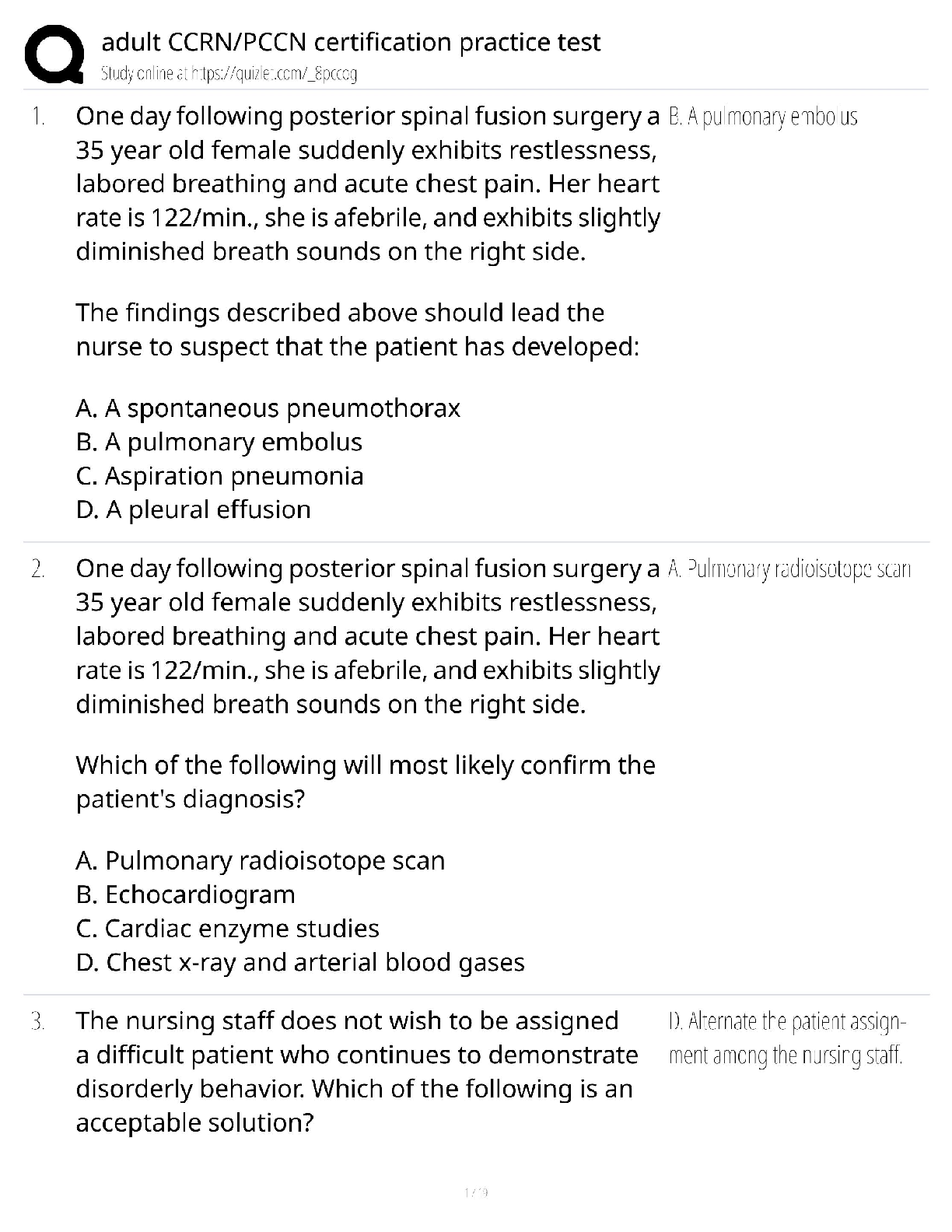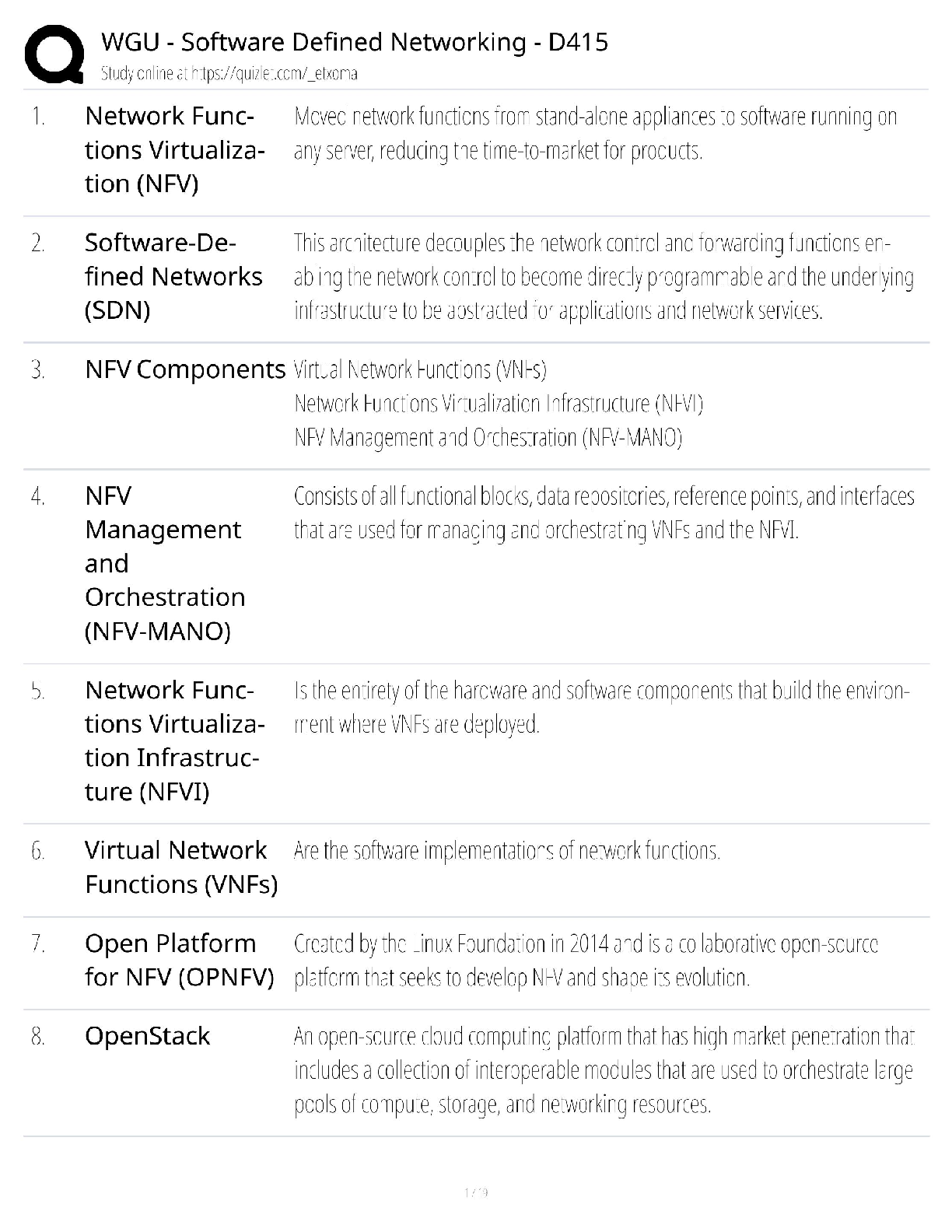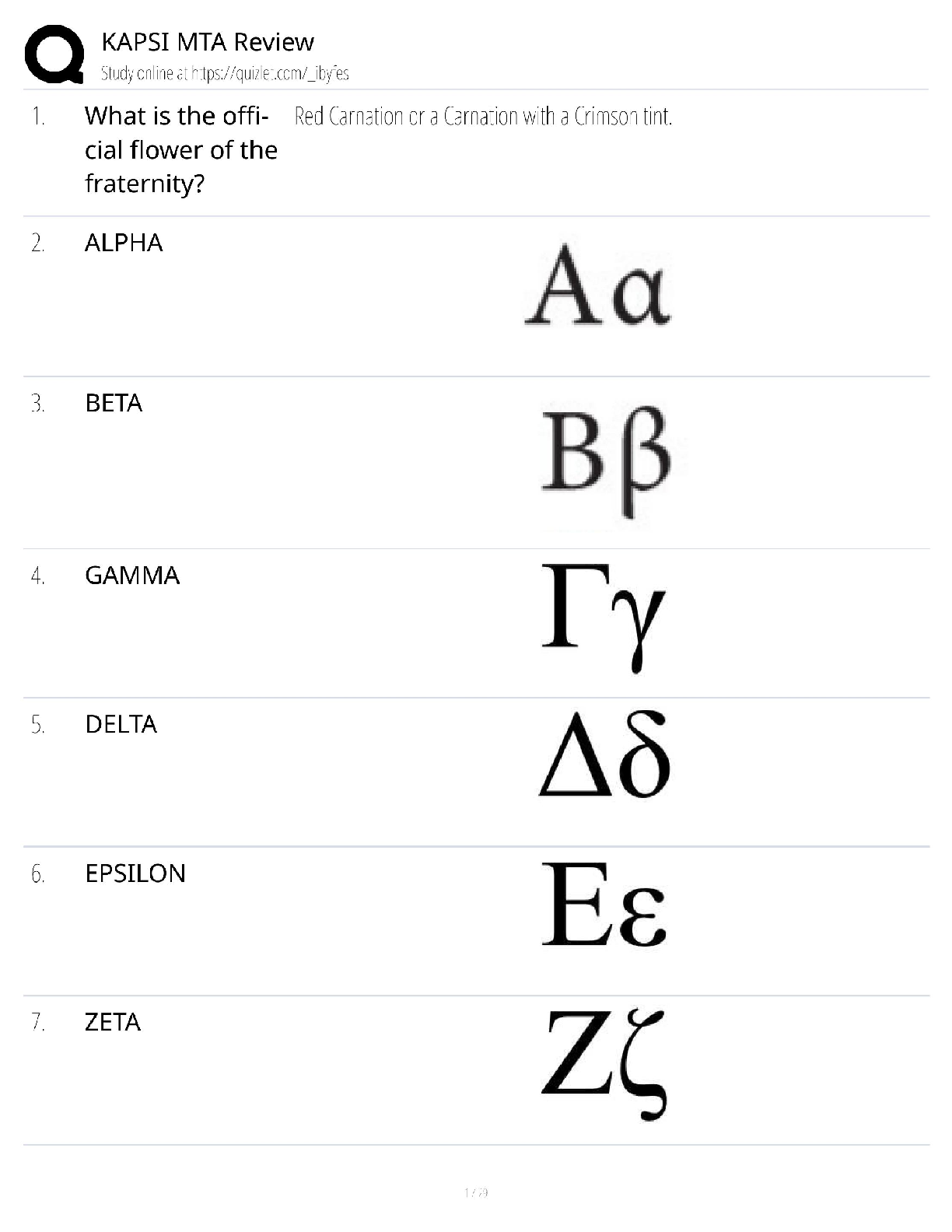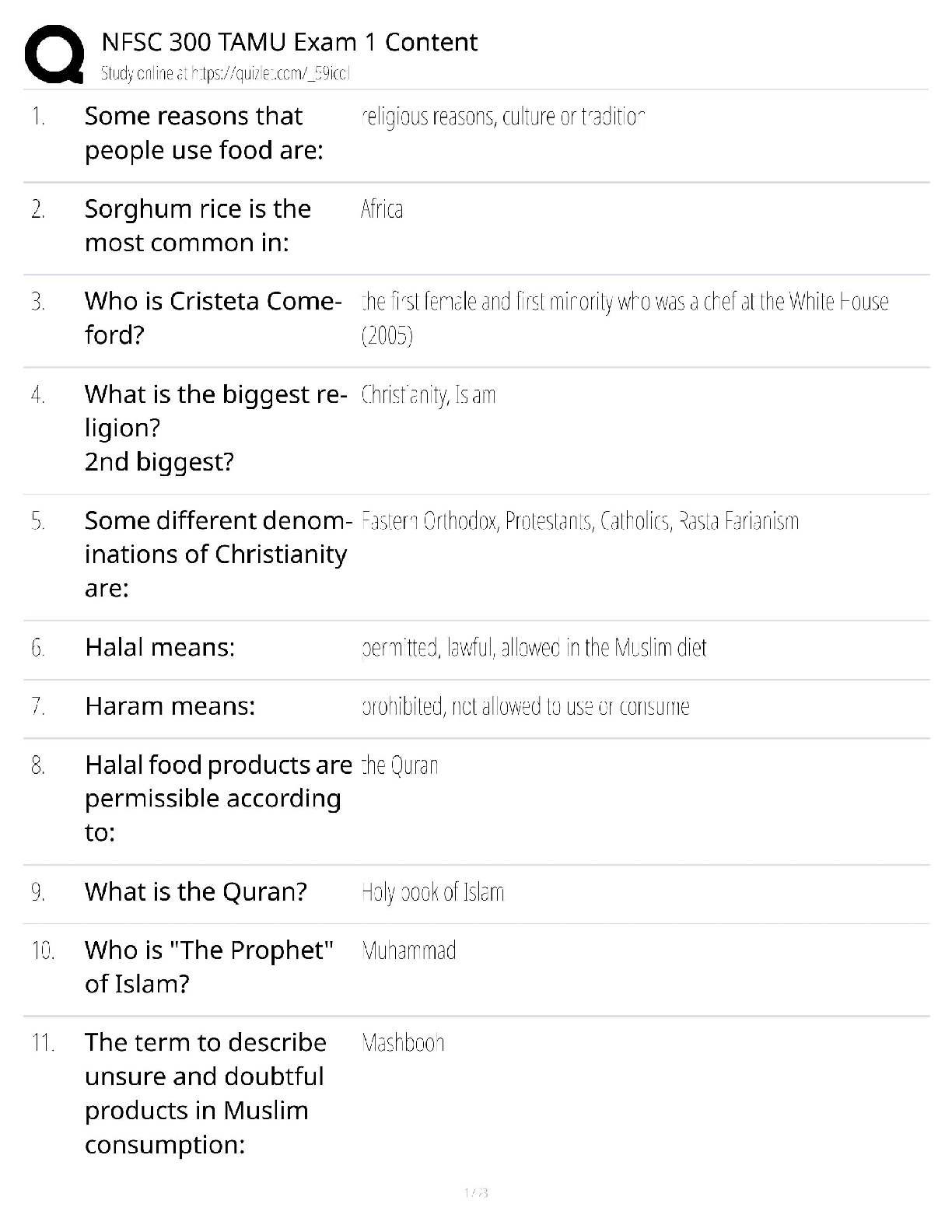Psychology > QUESTIONS & ANSWERS > Psyc 2314 Exam IV Pool Chapters17-22 new 100% A graded exam material questions and answers solved so (All)
Psyc 2314 Exam IV Pool Chapters17-22 new 100% A graded exam material questions and answers solved solution 2020
Document Content and Description Below
Psyc 2314 Exam IV Pool Chapters17-22 new 100% A graded exam material questions and answers solved solution 2020 1. Grace is in her early 20s and exercises regularly. As she ages, what is like ... ly going to encourage her to continue to exercise regularly? A) becoming a parent B) having an active friend C) getting married D) working 50+ hours each week 2. Young adults rarely experience serious illness because which three systems of body functioning tend to work in harmony? A) organ reserve, homeostasis, allostasis B) homeostasis, senescence, allostasis C) senescence, organ reserve, allostasis D) homeostasis, senescence, organ reserve 3. Exercise helps protect _____ from serious illness. A) adolescents B) emerging adults C) adults D) everyone 4. Chase exercises 6 days a week in order to have a fit, muscular, and attractive body. Chase is most likely what age? A) 20 years old B) 40 years old C) 60 years old D) 80 years old 5. Robert is just leaving his 11:00 a.m. college class and he is extremely hungry. He heads over to the cafeteria and orders a meal. After eating for about 10 minutes Robert is feeling full and decides not to finish the entire meal. Robert's behavior is likely under the influence of his _____. A) organ reserve B) body mass index C) set point D) optimal weight 6. Risk-taking during emerging adulthood _____. A) is usually beneficial to society B) is usually harmful to society C) rarely has an effect on society D) may benefit or harm society 7. The ratio between weight and height that is used to determine whether a person is below, at, or above normal weight is referred to as the _____. A) organ reserve B) body mass index C) set point D) optimal weight 8. Although the health of many emerging adults is good, some may be diagnosed with a chronic disease. All of the following are common diagnoses for this age group EXCEPT _____. A) high blood pressure B) cancer C) asthma D) diabetes 9. The CARDIA (Coronary Artery Risk Development in Adulthood) study began with over four thousand healthy 18- to 30-year-olds; most were reexamined 7 to 20 years later. The study found that _____. A) those who were the most fit at the first assessment were four times more likely to have diabetes and high blood pressure in middle age. B) those who were the least fit at the first assessment were four times more likely to have diabetes and high blood pressure in middle age. C) those who were the least and most fit at the first assessment were four times more likely to have diabetes and high blood pressure in middle age. D) there was no relation between fitness level at the first assessment and later health conditions. 10. Bella has been skipping meals and eating very little for months. One night she goes out with friends and eats a full, heavy meal. Within hours, she is vomiting and has diarrhea. Bella's symptoms are likely the result of a(n) _____ adjustment. A) organ reserve B) homeostatic C) senescence D) allostatic 11. Most emerging adults think that _____ is the purpose of sex. A) reproduction B) retaliation C) relationship D) recreation 12. A particular body weight that an individual's homeostatic processes strive to maintain is referred to as the _____. A) organ reserve B) body mass index C) set point D) optimal weight 13. Using a drug in a quantity or a manner that harms physical, cognitive, or psychosocial well-being is called drug _____. A) abuse B) use C) addiction D) dependence 14. Most boys reach their maximum height around age _____. A) 16 B) 18 C) 21 D) 30 15. Family members may know when a person is abusing drugs, and this gives them a chance to intervene. However, intervention is least likely during _____. A) adolescence B) emerging adulthood C) adulthood D) late adulthood 16. Which individual is most likely to be an STI vector? A) Michael, age 15 B) Thomas, age 23 C) Dean, age 39 D) Ross, age 55 17. CeCe, who is 25, just finished a 5-mile jog. While cooling down, she notices that it is harder to jog 5 miles now than it was when she was 18. CeCe is experiencing _____. A) senescence B) homeostasis C) hikikomori D) diathesis 18. Helena is participating in a study in which she has to decide if she should cheat on a test. She is asked to rank-order possible solutions to cheating on the test. Helena is participating in a study that is using a _____ Test. A) Moral Dilemma B) Thematic Apperception C) Defining Issues D) Peabody 19. Cognitively, what is needed to counter stereotypes? A) flexibility B) subjectivity C) objectivity D) dialect 20. A research study of people aged 13 to 45 found that logical skills improved from _____ to _____, then stayed steady, but social understanding continued to advance. A) adulthood; late adulthood B) adolescence; emerging adulthood C) emerging adulthood; middle adulthood D) emerging adulthood; late adulthood 21. When 18-year-old high school graduates of similar backgrounds and abilities are compared, those who begin jobs rather than going to college after graduation are more likely to eventually _____ than those who earned a college degree. A) achieve less and be more satisfied by middle age B) achieve more and be less satisfied by middle age C) achieve less and be less satisfied by middle age D) achieve more and be more satisfied by middle age 22. Most emerging adults struggle with _____, however, adults gradually master it as their cognition matures. A) base rate neglect B) time management C) distributed practice D) concrete thinking 23. A series of studies compared three groups of students: Koreans in Seoul, South Korea; Korean Americans who had lived most of their lives in the United States; and U.S.-born European Americans. Students in the study were asked to determine what information they would like to know in order to determine why a graduate student might have murdered a professor. Results revealed that _____ asked for more information, which suggested they were able to determine a more holistic, balanced synthesis. A) Koreans B) Korean Americans and European Americans C) Koreans and European Americans D) Koreans and Korean Americans 24. The study in which adults were asked to suggest solutions to various life problems demonstrated that _____. A) it was very difficult for adults to generate more than one solution B) familiarity with situations enabled adults to be more flexible C) problems that were particularly emotional immobilized many adults D) concrete thinkers generated the most solutions 25. A common logical error of emerging adults is delay discounting, the tendency to _____. A) undervalue events in the future B) use postformal thought C) use emotion instead of logic D) become more practical 26. Marge's marriage is troubled. She and her husband find very little joy in being with each other, in part because they have both changed as individuals. If Marge and her husband are capable of dialectical thinking, they will _____. A) adjust their relationship to accommodate the changes in themselves B) realize that divorce is the only solution C) try to find out which one of them is to blame D) try to reinstate their relationship as it was when they were first married 27. The psychometric approach to studying cognitive development analyzes intelligence using _____. A) IQ tests and other measures B) observation C) narratives D) physiological measures 28. Dr. Barnes tells his student Charlotte that she should pursue a career that will make her happy. She responds, “Not all careers that will make me happy will provide me with enough income to live.” Charlotte's response was a _____. A) synthesis B) thesis C) antithesis D) counterthesis 29. Tammy is taking a college admissions test in math to see if she can enroll in an accelerated math course. She has heard that males tend to perform better on this test than females, although she has no evidence that this statement is true. The proctor giving the test also might be concerned that Tammy is thinking that males might do better on this test as she has heard other students make such a comment. In order to reduce any stereotype threat that Tammy might be feeling, the proctor could make the following comment: A) “Try your hardest. That is all you can do.” B) “You may have heard that males tend to do better on this test, but I don't think that is true.” C) “You might not do as well as you would like, but all you can do is what your potential allows.” D) “All students show similar performance on this test.” 30. A possible fifth stage of cognitive development that characterizes adult thinking is _____. A) preformal thought B) semiformal thought C) informal thought D) postformal thought 31. The chance of leaving college without a degree becomes greater when all of the following occur EXCEPT _____. A) the size of the college increases B) income falls C) other life obligations increase D) classes get more difficult 32. Herman and Todd, two friends, are discussing logos on T-shirts. Herman says that everyone should be able to wear whatever logos they want on their T-shirts. Todd suggests that some logos may be offensive and thus shouldn't be worn. If Herman is able to integrate those two ideas, he will have created a _____. A) synthesis B) thesis C) antithesis D) counterthesis 33. On his own time, Ron looked over his course syllabi for the term and realized that, in three weeks, he had three assignments due on one day. Ron decided he would do one assignment per week for the next three weeks so that he would have them all done by their due dates. Ron is demonstrating _____ thinking. A) preoperational B) concrete operational C) formal operational D) postformal 34. Dr. Richardson asks her class which age group is most in favor of same-sex marriage. A student raises his hand and correctly identifies _____ as being most in favor of it. A) emerging adults B) young adults C) middle-aged adults D) older adults 35. For most people, social networking has _____ social isolation in emerging adulthood. A) increased B) decreased C) had no impact on D) created 36. What domestic abuse behavior are women consistently more likely to experience than men? A) strangling B) threats C) slapping D) insults 37. A popular term for parents who hover over their emerging adults, ready to swoop down if any problem arises, is _____ parents. A) hovering B) vigilant C) helicopter D) supportive 38. Which statement about personality in emerging adulthood is TRUE? A) After the age of 12, personality is static. B) Personality is dynamic, but only if individuals have achieved their identity. C) Personality is not plastic. D) Personality can change after adolescence. 39. Peyton and Chris are long-time friends who have just transitioned to a “friends with benefits” relationship. If their friendship truly comes first, Sternberg's triadic theory would suggest that their relationship is _____ but not _____. A) passionate; intimate B) intimate; passionate C) consummate; romantic D) romantic; intimate 40. Patricia and Raul live together as a romantic couple but they are not married. Their living arrangement is called _____. A) a dual relationship B) a hookup C) romance D) cohabitation 41. Hilda and Harley have been married for two years. Hilda has come home after a long day of work and found the breakfast dishes in the sink and the unfolded laundry in the laundry basket. Harley said he would wash the dishes and fold the clothes before he left for work that morning. When the upset Hilda begins to yell at Harley, he simply turns up the television volume. Hilda gets louder, but Harley walks out of the room and slams the door. Hilda and Harley have just engaged in _____. A) relational aggression B) intimate terrorism C) situational couple violence D) a demand/withdraw interaction 42. During emerging adulthood, self-esteem and happiness _____ for most people. A) decrease B) increase C) stay the same D) do not exist 43. A longitudinal study found that aggressive 4-year-olds who matured into aggressive emerging adults were defined in all of the following ways EXCEPT _____. A) as repeatedly arrested serious offenders B) as having as many friends as their average peers C) as desiring additional education D) as perceiving themselves as being quite conscientious 44. According to the text, the relatively low rate of interethnic marriages is attributable to _____. A) the formation of romantic relationships of similar backgrounds B) the formation of romantic relationships of highly varied backgrounds C) disapproval of interethnic marriage by emerging adults D) disapproval of interethnic marriage by parents 45. About _____ of all emerging adults receive cash from their parents in addition to tuition, medical care, food, and other material support. A) one-fourth B) one-third C) one-half D) three-fourths 46. Personality traits present at age 18 _____. A) never disappear by age 25 B) rarely disappear by age 25 C) usually disappear by age 25 D) always disappear by age 25 47. Anthropologists distinguish between _____, or marriage within the same tribe or ethnic group, and _____, marriage outside the group. A) homogamy; heterogamy B) heterogamy; homogamy C) homozygous; heterozygous D) heterozygous; homozygous 48. A situation in a romantic relationship wherein one partner wants to address an issue and the other refuses, resulting in opposite reactions, is referred to as _____. A) choice overload B) intimate terrorism C) situational couple violence D) demand/withdraw interaction 49. Intimacy is the desire for _____. A) social connection B) generativity C) sexual intercourse D) self-esteem 50. Joel was a very aggressive 4-year-old boy. During emerging adulthood, he is LEAST likely to _____. A) graduate from school B) be arrested C) experience conflict in friendships D) have a job 51. When heterosexual couples are romantically committed to each other they tend to have _____ cross-sex friendships. A) more B) extra C) fewer D) no 52. During the past 50 years, advances in medicine have solved about half of all _____. A) age-related diseases B) fertility problems C) sexually transmitted infections D) birth control side effects 53. In an aging brain _____. A) neurons fire faster B) reaction time lengthens C) brain size increases D) multitasking becomes easier 54. Women experience menopause; men experience _____. A) testeropause B) libidopause C) andropause D) spermatopause 55. A researcher is compiling data on the incidence of several different diseases. These data reflect _____. A) mortality B) morbidity C) disability D) vitality 56. Which country has the highest rate of individuals diagnosed with diabetes? A) the United States B) Mexico C) the United Kingdom D) Canada 57. The first visible signs of senescence are usually observed in a person's _____. A) gait B) posture C) skin D) eyes 58. According to the text, what two factors protect health? A) money and education B) money and attitudes C) attitudes and education D) attitudes and expectations 59. Alice has diabetes, but tells everyone that she feels healthy and energetic. How Alice feels would be associated with a high score on a measure of _____. A) disability B) vitality C) morbidity D) mortality 60. In vitro fertilization (IVF), an assisted reproductive technology (ART), has resulted in an estimated _____ million births. A) 5 B) 10 C) 15 D) 20 61. The “Mediterranean” diet has been shown to protect against heart disease without adding weight. If Al were to eat a Mediterranean diet he would eat all of the following EXCEPT _____. A) fish B) olive oil C) vegetables D) beef 62. Janice, who is 55 years old, needed to get three projects done by the end of the week at work. When she was younger she would have worked on all three projects more or less at the same time. Now that she is older, however, Janice needs to work on one project at a time. Janice's current inability to multitask is due to changes in her _____. A) vision B) flexibility C) brain D) expertise 63. At what age is an individual likely to experience the slowest sexual arousal? A) 18 years old B) 30 years old C) 45 years old D) 60 years old 64. If he is typical, a 45-year-old man will probably state that he feels _____ his chronological age. A) significantly older than B) exactly C) half D) 5 to 10 years younger than 65. Which vision change is NOT associated with aging? A) longer adjustment time to darkness B) decreasing farsightedness C) slowed motion perception D) peripheral vision decreases 66. Jim, who is 60, couldn't understand why he kept slowly gaining weight. He was eating the same amount of food that he had each day since he was 20 and he got regular exercise. What could explain his weight gain? A) His metabolism had slowed down. B) He is likely very ill; this situation is very unusual. C) He really wasn't gaining weight; his height was decreasing. D) He overate due to regular exercise. 67. At a recent doctor's visit, Ted's doctor informed him that he is at an age when he is likely to experience lower testosterone levels. Ted was informed that, due to lower testosterone levels, he could experience a reduction in all of the following EXCEPT _____. A) sexual desire B) muscle mass C) erections D) hair loss 68. When the thought required for an action has become routine, and it appears that most aspects of the task are performed instinctively, the performance of the task is _____. A) automatic B) optimized C) compensated D) efficient 69. Fluid intelligence includes _____. A) a knowledge of geographical facts B) the speed of processing mathematical information C) the size of one's science vocabulary D) the ability to recognize and name famous paintings 70. The two researchers who concluded that fluid and crystallized intelligence are the most crucial aspects of intelligence were _____. A) Bayley and Oden B) Cattell and Horn C) Jones and Conrad D) Sternberg and Gardner 71. Which example relies MOST heavily on crystallized intelligence? A) putting together a puzzle B) knowing the chemical symbols for various elements C) recalling a list of 10 words D) analyzing relationships between concepts 72. The most crucial cognitive difference between a skilled person and an unskilled person may be _____. A) strategy B) automatic processing C) intuition D) flexibility 73. Dr. Fine was interested in assessing the “g,” or general intelligence, of college students so he assessed abilities in all of the following areas EXCEPT_____. A) memory B) vocabulary C) reasoning D) agility 74. The older Gary gets the more difficult it is going to be for him to _____. A) define the word “homemade” B) answer what comes next in the series “4916253” C) recall the seventh president of the United States D) learn the meaning of a new word 75. Nathanial is a participant in a research study. He needs to decide how Figure A relates to Figure B. Nathanial will need to use _____ in order to solve this problem. A) creative intelligence B) practical intelligence C) fluid intelligence D) crystallized intelligence 76. Longitudinal research on intelligence found that IQ scores _____. A) increased after the early 20s B) decreased after the early 20s C) remained stable after the early 20s D) fluctuated after the early 20s 77. The research design that involves testing groups of subjects of different ages multiple times and comparing their scores with their own scores in previous periods in addition to the scores of new groups of adults of the same ages is called _____. A) longitudinal or long-term research B) cross-sectional research C) retesting research D) cross-sequential research 78. Research on taxi drivers in London indicates that drivers with more experience _____. A) developed higher IQs through their work B) had brains that adjusted to the need for a particular kind of knowledge C) became less effective over time as they tuned out details D) had slower processing skills than younger drivers 79. An expert internal medicine doctor may prefer a patient who _____. A) has a clearly diagnosable condition B) is in perfect health C) has symptoms that do not match any diagnosable condition D) does not come in for medical care until their home remedies fail 80. A study of adults aged 34 to 83 found that people high in fluid intelligence were exposed to _____ stress and were _____ likely to suffer from it. A) more; more B) less; less C) more; less D) less; more 81. What does the KIDI scale measure? A) knowledge of infant digestion B) knowledge of infant development C) knowledge of information development D) knowledge of indicators of depression 82. The term g refers to _____ intelligence. A) grand B) general C) great D) gross 83. Cynthia has just experienced a hassle, which could influence her cognitive functioning. She has MOST likely just experienced _____. A) the death of a loved one B) the birth of a child C) a job loss D) a traffic jam 84. Which personality trait tends to increase with age? A) extroversion B) openness C) agreeableness D) neuroticism 85. Since they are called on to help both the older and younger generations of the family, middle-aged adults have been called the _____. A) midlife generation B) family caregivers C) kinkeepers D) sandwich generation 86. People in Maslow's third level on the hierarchy of needs seek _____. A) self-actualization B) safety C) generativity D) love and belonging 87. According to a study in the U.S., which population scored highest in openness? A) West Virginians B) New Mexicans C) New Yorkers D) North Dakotans 88. A study of 7,578 adults in seven nations found that physical separation between parents and adult children _____. A) weakened family ties B) created conflict between parents and the adult children C) strengthened the relationships between parents and adult children D) caused parents to spend more time and resources supporting adult children 89. Manuel and Rosa have been married for nearly 30 years. Their youngest child left home six months ago. If they are typical, the quality of their marriage should _____. A) remain constant, no different than earlier years B) worsen since there are no children to act as buffers C) be tumultuous since they had grown apart over the years D) improve since they have more time to spend together 90. According to Erikson, the developmental crisis that occurs after intimacy versus isolation is _____. A) initiative versus guilt B) identity versus role confusion C) generativity versus stagnation D) integrity versus despair 91. When Rob graduated from college, he found a good job, a nice apartment, and made new friends. Now, three years later, he has been laid off from his work and he has moved back into his parents' home. Statistically, Rob will likely _____. A) feel comfortable staying with his parents B) feel uncomfortable staying with his parents C) report tension in his relationship with his parents D) find that his parents are more nurturing 92. Of adults born before 1940, what percentage got married? A) 10 B) 33 C) 50 D) 96 93. Ronald seems to thrive on changing jobs, is artistic, and likes to try new things. He would be rated high on the personality dimension called _____. A) extroversion B) openness C) neuroticism D) sociability 94. An acquaintance who is not a friend but still has an impact on an adult's life is called a(n) _____. A) social convoy B) kinkeeper C) consequential stranger D) fictive kin 95. Those who know her describe Matilda as a kind, helpful, and easygoing person. She is high on which of the Big Five traits? A) agreeableness B) neuroticism C) openness D) conscientiousness 96. Who is more likely to be depressed as an adult? A) Alice, who has a good job and is financially comfortable. B) Dora, who has a good groups of friends who provide her with emotional support. C) Peg, who is unemployed and is emotionally and financially supported by her friends. D) Kate, who is unemployed and is emotionally and financially supported by her parents. 97. Randy moved across the country to advance his career. Though he moved alone, he soon developed a group of coworkers and friends who became like a family to him. They served as his _____. A) kinkeeper B) fictive kin C) social convoy D) clique 98. Mel is a retired stockbroker who enjoys tutoring children at the local YMCA after school. He is demonstrating the psychosocial stage of _____. A) generativity versus stagnation B) integrity versus despair C) identity versus role confusion D) industry versus inferiority 99. The Big Five personality traits _____. A) are present in highly varying degrees throughout much of adulthood B) apply only to people living in North America C) first become obvious in preschool children D) are apparent in every culture and era 100. How do consequential strangers differ from friends? A) They include people from a wider variety of faiths, ethnic groups, ages, and political opinions. B) They include only people of the same religion, ethnic group, age, or political opinion. C) They do not play a role in a person's daily life activities. D) Unlike a friend, consequential strangers know nothing about a person. [Show More]
Last updated: 3 years ago
Preview 1 out of 20 pages

Buy this document to get the full access instantly
Instant Download Access after purchase
Buy NowInstant download
We Accept:

Reviews( 0 )
$12.00
Can't find what you want? Try our AI powered Search
Document information
Connected school, study & course
About the document
Uploaded On
Dec 23, 2020
Number of pages
20
Written in
All
Additional information
This document has been written for:
Uploaded
Dec 23, 2020
Downloads
0
Views
102

 answers.png)











